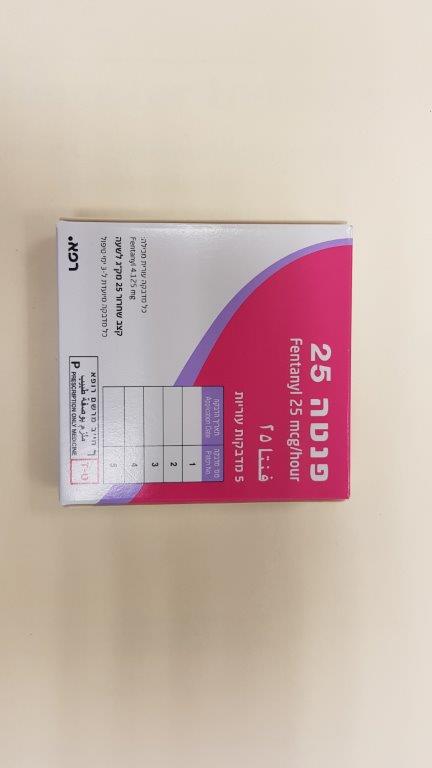Quest for the right Drug

פנטה 25 FENTA 25 (FENTANYL)
תרופה במרשם
תרופה בסל
נרקוטיקה
ציטוטוקסיקה
צורת מתן:
בין-עורי : TRANSDERMAL
צורת מינון:
מדבקות : PATCHES
עלון לרופא
מינוניםPosology התוויות
Indications תופעות לוואי
Adverse reactions התוויות נגד
Contraindications אינטראקציות
Interactions מינון יתר
Overdose הריון/הנקה
Pregnancy & Lactation אוכלוסיות מיוחדות
Special populations תכונות פרמקולוגיות
Pharmacological properties מידע רוקחי
Pharmaceutical particulars אזהרת שימוש
Special Warning עלון לרופא
Physicians Leaflet
Interactions : אינטראקציות
4.5 Interaction with other medicinal products and other forms of interaction Pharmacodynamic-related interactions Centrally-acting medicinal products/Central Nervous System (CNS) depressants, including alcohol and CNS depressant narcotic drugs The concomitant use of Fenta TDP with other central nervous system depressants (including benzodiazepines and other sedatives/ hypnotics, opioids, general anaesthetics, phenothiazines, tranquilisers, sedating antihistamines, alcohol and CNS depressant narcotic drugs), skeletal muscle relaxants, and gabapentinoids (gabapentin and pregabalin) may result in respiratory depression, hypotension, profound sedation, coma or death. Concomitant prescribing of CNS depressants and Fenta TDP should be reserved for patients for whom alternative treatment options are not possible. The use of any of these medicinal products concomitantly with Fenta TDP requires close monitoring and observation. The dose and duration of concomitant use should be limited (see section 4.4). . Monoamine Oxidase Inhibitors (MAOI) Fenta TDP is not recommended for use in patients who require the concomitant administration of an MAOI. Severe and unpredictable interactions with MAOIs, involving the potentiation of opiate effects or the potentiation of serotoninergic effects, have been reported. Fenta TDP should not be used within 14 days after discontinuation of treatment with MAOIs. Serotonergic medicinal products Co-administration of fentanyl with serotonergic medicinal products, such as a Selective Serotonin Re-uptake Inhibitor (SSRI) or a Serotonin Norepinephrine Re-uptake Inhibitor (SNRI) or a Monoamine Oxidase Inhibitor (MAOI), may increase the risk of serotonin syndrome, a potentially life-threatening condition. Use concomitantly with caution. Carefully observe the patient, particularly during treatment initiation and dose adjustment (see section 4.4). Concomitant use of mixed opioid agonists/antagonists The concomitant use of buprenorphine, nalbuphine or pentazocine is not recommended. They have high affinity to opioid receptors with relatively low intrinsic activity and therefore partially antagonise the analgesic effect of fentanyl and may induce withdrawal symptoms in opioid dependent patients (see section 4.4). Pharmacokinetic-related interactions Cytochrome P450 3A4 (CYP3A4) Inhibitors Fentanyl, a high clearance active substance, is rapidly and extensively metabolised mainly by CYP3A4. The concomitant use of Fenta TDP with cytochrome P450 3A4 (CYP3A4) inhibitors may result in an increase in fentanyl plasma concentrations, which could increase or prolong both the therapeutic and adverse effects, and may cause serious respiratory depression. The extent of interaction with strong CYP3A4 inhibitors is expected to be greater than with weak or moderate CYP3A4 inhibitors. Cases of serious respiratory depression after coadministration of CYP3A4 inhibitors with transdermal fentanyl have been reported, including a fatal case after coadministration with a moderate CYP3A4 inhibitor. The concomitant use of CYP3A4 inhibitors and Fenta TDP is not recommended, unless the patient is closely monitored (see section 4.4). Examples of active substances that may increase fentanyl concentrations include: amiodarone, cimetidine, clarithromycin, diltiazem, erythromycin, fluconazole, itraconazole, ketoconazole, nefazodone, ritonavir, verapamil and voriconazole (this list is not exhaustive). After coadministration of weak, moderate or strong CYP3A4 inhibitors with short-term intravenous fentanyl administration, decreases in fentanyl clearance were generally ≤25%, however with ritonavir (a strong CYP3A4 inhibitor), fentanyl clearance decreased on average 67%. The extent of the interactions of CYP3A4 inhibitors with long-term transdermal fentanyl administration is not known, but may be greater than with short-term intravenous administration. Cytochrome P450 3A4 (CYP3A4) Inducers The concomitant use of transdermal fentanyl with CYP3A4 inducers may result in a decrease in fentanyl plasma concentrations and a decreased therapeutic effect. Caution is advised upon concomitant use of CYP3A4 inducers and Fenta TDP. The dose of Fenta TDP may need to be increased or a switch to another analgesic active substance may be needed. A fentanyl dose decrease and careful monitoring is warranted in anticipation of stopping concomitant treatment with a CYP3A4 inducer. The effects of the inducer decline gradually and may result in increased fentanyl plasma concentrations, which could increase or prolong both the therapeutic and adverse effects, and may cause serious respiratory depression. Careful monitoring should be continued until stable drug effects are achieved. Examples of active substance that may decrease fentanyl plasma concentrations include: carbamazepine, phenobarbital, phenytoin and rifampicin (this list is not exhaustive). Paediatric population Interaction studies have only been performed in adults.

שימוש לפי פנקס קופ''ח כללית 1994
לא צוין
תאריך הכללה מקורי בסל
01/01/2000
הגבלות
תרופה מוגבלת לרישום ע'י רופא מומחה או הגבלה אחרת
מידע נוסף
עלון מידע לצרכן
07.08.22 - עלון לצרכן אנגלית 07.08.22 - עלון לצרכן עברית 07.08.22 - עלון לצרכן ערבית 04.01.23 - עלון לצרכן עברית 06.03.23 - עלון לצרכן אנגלית 06.03.23 - עלון לצרכן עברית 06.03.23 - עלון לצרכן ערבית 16.08.23 - עלון לצרכן אנגלית 16.08.23 - עלון לצרכן עברית 16.08.23 - עלון לצרכן ערבית 23.05.19 - החמרה לעלון 13.06.19 - החמרה לעלון 28.02.22 - החמרה לעלון 18.01.15 - החמרה לעלון 04.01.23 - החמרה לעלוןלתרופה במאגר משרד הבריאות
פנטה 25